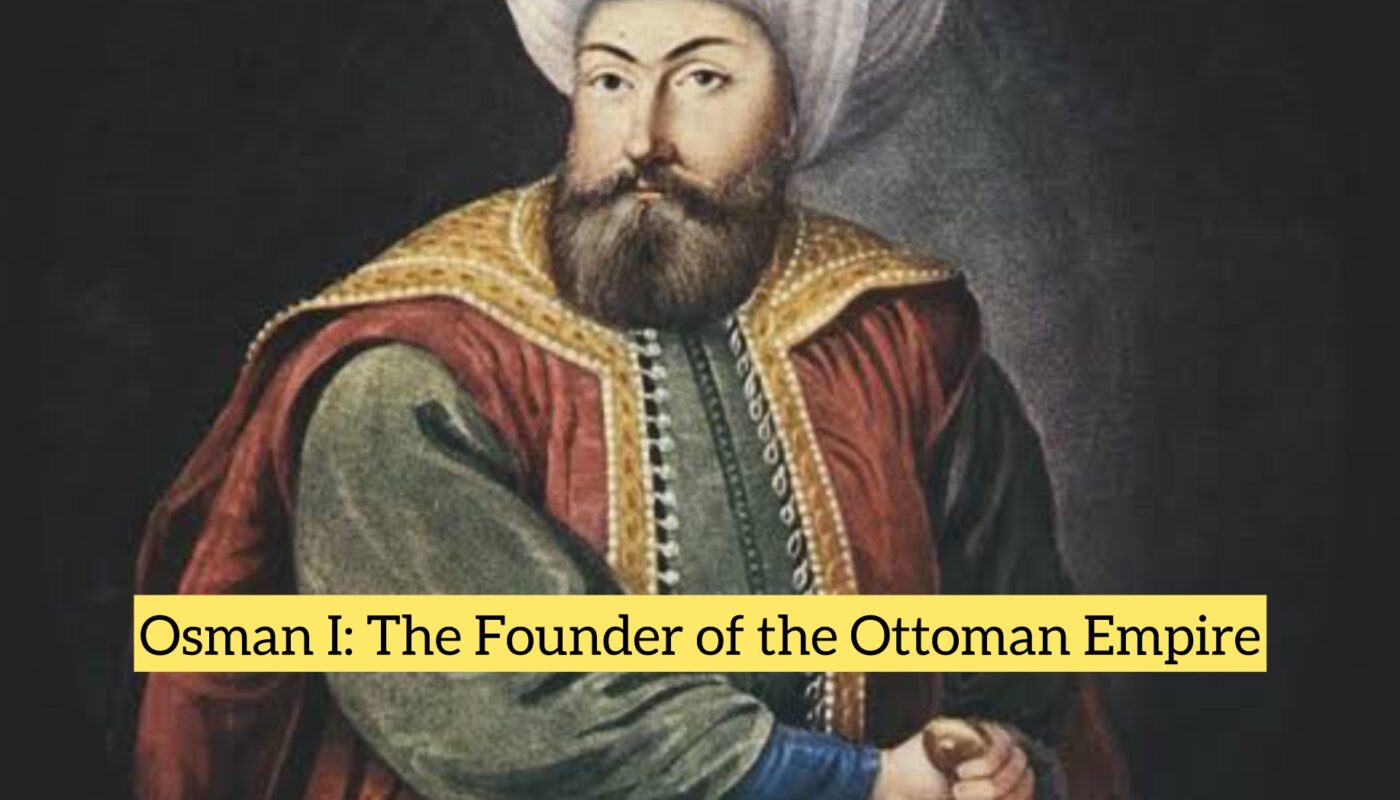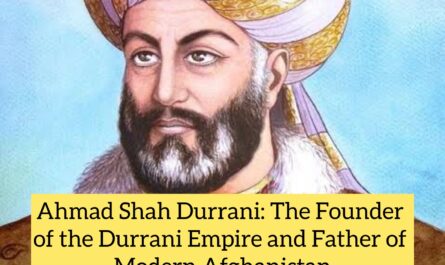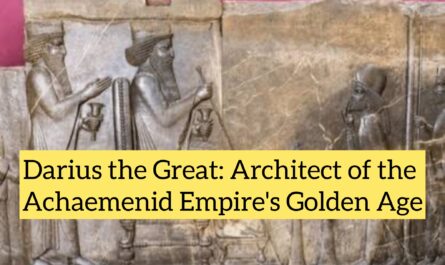Introduction
Osman I (1258–1326), also known as Osman Gazi, was the founder of the Ottoman Empire, one of the most powerful empires in world history. His leadership laid the foundations for the expansion of the empire, which would eventually span across three continents and last for over 600 years. Osman’s reign, although brief, marked the beginning of a new era in Anatolia and the Balkans, leading to the establishment of the Ottoman dynasty that would dominate the region for centuries.
Osman I’s contributions to the Ottoman state, both in terms of military conquest and governance, are legendary. His vision, strategic brilliance, and ability to unite various Turkish tribes in the region set the stage for the rise of an empire that would become one of the most powerful in the medieval world.
Early Life and Background
Birth and Family
Osman I was born around 1258 CE in the town of Söğüt (modern-day Turkey), located in the region of Bithynia, which was part of the Seljuk Sultanate of Rum at the time. Osman’s father, Ertuğrul Bey, was a leader of the Kayi tribe, one of the Turkic tribes that migrated from Central Asia into Anatolia in the 11th and 12th centuries.
Ertuğrul had been a military commander under the Seljuk Sultan and had settled in Söğüt, a town near the Byzantine border. The Kayi tribe, like many others, had been hired by the Seljuks as mercenaries to fight against the Byzantine Empire and other rival states in the region.
As a young man, Osman likely grew up in an environment of constant military activity, and he would have learned the ways of leadership, warfare, and governance from his father. Osman’s early exposure to the political and military struggles of the time shaped his future as a leader.
Rise to Power
After the death of Ertuğrul in around 1281, Osman succeeded him as the chief of the Kayi tribe. During this period, the Seljuk Sultanate of Rum was weakening, and the Byzantine Empire was in decline. This created an opportunity for Osman to establish his own power base.
Osman’s early leadership was marked by a series of wars and alliances with neighboring states. The Kayi tribe had long been a part of the larger Turkish Ghazi (warrior) tradition, fighting both for the Seljuks and against the Christian Byzantine forces. Osman capitalized on the political vacuum in Anatolia after the collapse of the Seljuk Sultanate, and he began his campaigns against the Byzantine Empire and other local Turkish chieftains.
Establishment of the Ottoman Beylik
The First Campaigns
Osman’s most significant early achievement was the establishment of his own beylik (principality). Around the turn of the 14th century, Osman began to carve out a state for himself in northwestern Anatolia, with Söğüt as his base. The region was strategically located between the Byzantine Empire and the Seljuk Sultanate, which were both weakened by internal strife.
Osman’s military strategy was a blend of traditional Turkic cavalry tactics and guerrilla warfare, making use of the region’s mountainous terrain to outmaneuver larger, more established Byzantine forces. He quickly gained a reputation for being both a fierce warrior and a savvy leader, able to win the loyalty of other Turkish tribes in the region.
By 1300, Osman had already begun to expand his territory, capturing Bursa, a key city in the Byzantine Empire. This victory laid the foundation for the future expansion of the Ottoman state, as Bursa would later become the first major capital of the Ottoman Empire.
Strategic Alliances and Diplomacy
In addition to his military prowess, Osman was also a skilled diplomat. He formed alliances with other Turkish tribes in the region, many of which were disillusioned with the weakening Seljuk Sultanate and the Byzantine Empire. Through these alliances, Osman gained support for his campaigns, both in terms of manpower and resources.
Osman’s ability to balance diplomacy and military force allowed him to gradually expand his influence. He also attracted many followers with promises of land and the possibility of spoils from further conquests, which helped him build a loyal and capable army.
Conquests and Expansion
Key Victories and Territorial Expansion
Osman’s military success can be attributed to several key battles and sieges that allowed him to steadily expand his territory:
-
The Battle of Bapheus (1302):
One of the most significant battles in Osman’s early career, the Battle of Bapheus was fought between Osman’s forces and the Byzantine army near Nicaea (modern-day Iznik). The Byzantine forces, led by the Byzantine emperor or local governor, were decisively defeated, marking a turning point in the struggle for control of Anatolia. This victory not only solidified Osman’s hold on his lands but also boosted his reputation as a formidable military leader. -
The Fall of Nicaea:
Following the victory at Bapheus, Osman laid siege to Nicaea (modern-day Iznik), one of the most important Byzantine cities in the region. Although Nicaea did not fall during Osman’s lifetime, his persistent pressure on Byzantine positions weakened the Empire’s hold on the region. -
The Capture of Bursa (1326):
The capture of Bursa, which became the first major Ottoman capital, was a major milestone in Osman’s expansion. Bursa was strategically located and offered the Ottomans both economic and political advantages. It was a thriving urban center with excellent access to trade routes, which helped consolidate Osman’s power in the region. After its fall, Bursa became a hub for Islamic learning, commerce, and military activity.
Military Tactics and Innovations
Osman was a skilled strategist who utilized several tactics that would later define Ottoman military doctrine:
-
Cavalry Tactics: Like other Turkish leaders, Osman relied heavily on mounted archers and light cavalry, which were highly mobile and could harass larger, slower Byzantine forces.
-
Siege Warfare: Osman’s forces used advanced siege techniques, including the construction of siege engines and the use of blockades to isolate and weaken Byzantine cities.
-
Psychological Warfare: Osman understood the importance of morale and used psychological tactics, including swift raids and surprise attacks, to unsettle his enemies.
Governance and Legacy
Foundation of the Ottoman State
Osman I’s leadership was not just about military conquest but also about laying the foundations for the governance of the lands he had conquered. He established a tribal confederation that was based on Islamic principles but also incorporated Turkic customs.
The governance system he created was highly decentralized, with local leaders (called Beys) given significant autonomy as long as they pledged allegiance to Osman and his successors. He also established a military elite known as the Sipahi, which was based on a feudal system of land grants in exchange for military service.
Cultural Contributions
Osman’s reign also saw the growth of Islamic culture and architecture within the Ottoman state. While the empire would reach its artistic and cultural zenith under future sultans, Osman’s policies laid the groundwork for the Ottoman Empire’s deep engagement with Islamic arts, education, and religious practices.
Succession and the Birth of the Ottoman Dynasty
Osman I died in 1326, shortly after the conquest of Bursa, and was succeeded by his son Orhan I. His son would go on to expand the Ottoman Empire further, particularly into the Balkans, and solidify the foundation laid by Osman.
Osman’s successors continued to build on his conquests, eventually leading to the rise of an empire that would stretch across Europe, Asia, and Africa, becoming one of the longest-lasting empires in world history.
Legacy of Osman I
A Symbol of Turkish Nationalism
Osman I is seen as a foundational figure in both the Ottoman Empire and in Turkish nationalism. His legacy continues to inspire national pride in Turkey, where he is considered the father of the Ottoman dynasty and a symbol of the Turkish warrior tradition.
The Rise of the Ottoman Empire
Osman I’s reign marks the beginning of the Ottoman Empire, which would grow to dominate the Middle East, Southeastern Europe, and parts of North Africa. His military genius, leadership, and ability to unite diverse peoples under one banner were key to the success of the empire.
Conclusion
Osman I was not just a military leader but a visionary who laid the foundations for what would become one of the most powerful empires in world history. His achievements in both warfare and statecraft created an enduring legacy that would shape the world for centuries to come. Through his leadership, the Ottoman Empire would go on to last over 600 years, leaving a profound mark on the history of the world.



